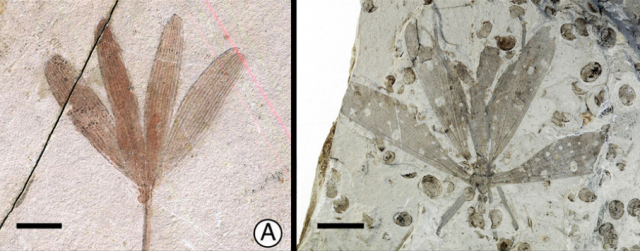
File this one under turning-lemons-into lemonade: instead of getting frustrated by the difficulty of keeping track of fossil specimens—or maybe in addition to getting frustrated—Yongjie Wang at the College of Life Sciences in Beijing parlayed the confusion into the identification of a new species. The confusion came because the extinct hangingfly looks almost exactly like an extinct ginkgo leaf. Researchers speculate that the bugs may have mimicked the leaves in order to escape predators, and may also have provided a protective function, preventing other bugs from eating real leaves nearby.
Wang is not the first fossil collector to get his leaf and wing specimens mixed up. Modern leaf-mimicking insects were described in the tropics in the late 1930s. Once it was determined that this was no mere coincidence—that the bugs had evolved to look like the leaves as a strategy to avoid predators—fossil hunters remembered the similarities they had seen in their specimens. They thought: if bugs are imitating leaves now, maybe they were also doing it back in the day.
The Jiulongshan Formation, a rock deposit in Northeastern China’s Inner Mongolia, is full of fossils dating from the late Middle Jurassic—roughly a hundred and seventy million years ago. Back then, there were many more types of both Mecoptera (the order of insects that includes hangingflies) and Ginkgoales than there are today.
Wang et al. found that when one hangingfly species extended its wings, one of these bugs, Juracimbrophlebia ginkgofolia, would look just like the multilobed leaf from a ginkgo tree that lived at the same time, Yimaia capituliformis. They report that these trees and others with similar leaves comprised 12.4 percent of the total number of plant species in the area, so they would provide great camouflage for the hangingflies.
J. ginkgofolia were big bugs, with weak legs and wings, which is perhaps why they developed this mimetic strategy to avoid detection. Y. capituliformis were extinct by the Cretaceous, a hundred and sixty-six million years ago, and J. ginkgofolia seems to have been gone by then as well. The hangingflies that survived to the present day never resembled ginkgo leaves as much as those that died out—with the ginkgos largely dying off, that may be why they are the ones still hanging around.
www.pnas.org/cgi/doi/10.1073/pnas.1205517109
reader comments
9